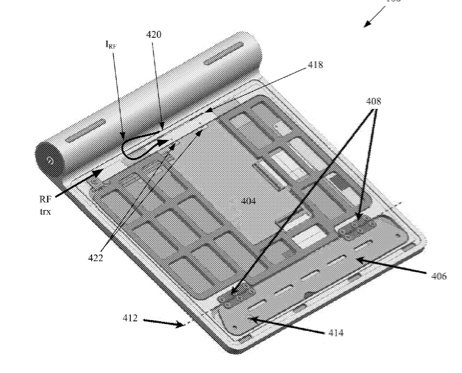An Apple patent (number 20110310029) for a portable, multi-touch input device has appeared at the US Patent & Trademark Office and involves the Magic Trackpad.
Per the patent (first graphic), the portable input device can wirelessly send control signals to an external circuit. The control signals can derive from touch or gestures applied to a touch sensitive surface. The control signals can also include a mouse click equivalent control signal generated by mechanical manipulation of the portable input device. The inventors are Erik A. Uttermann, Rico Zorkendorfer, Andrew Lauder and Sean S. Corbin.
Along the same lines, there’s an Apple patent (20110310536) for a device foot. A moveable device foot (second graphic) for an electronic device is described. The device foot can include a rigid weight bearing member and a flexible sealing member that is integrally formed with the weight bearing member. The device foot can be formed using a double-shot injection molding process. The weight bearing member of the foot can be mounted to an interior portion of the electronic device such that it extends through an external casing of the electronic device.
The flexible sealing member can be mounted to the external casing to seal the interior of the electronic device. During operation of the electronic device, the device foot can be configured to move relative to the external casing, such as in response to an external force applied to the electronic device. The inventors are Erik A. Uttermann, Rico Zorkendorfer and Andrew Lauder.
Finally, a new Apple patent (number 20110314343) involves capturing and displaying state of automated user-level testing of a graphical user interface application (third graphic). In one embodiment, an automated user-level testing tool is enhanced to capture additional information about the state of the automated testing, beyond just a screenshot of the application-under-test.
In another embodiment, an automated user-level testing tool is enhanced to capture testing state information for multiple points in time (referred to as “snapshots”), beyond just when the application-under-test crashes, This captured information from one execution of an automated test (one “test run”) is stored in one test log, which can then be viewed using a test log viewer. In one embodiment, the graphical user interface (GUI) for the test log viewer includes four areas: a screenshot area, a test script area, a stack trace area, and a timing area.
The content shown in the screenshot area, the test script area, and the stack trace area is specific to a particular point in time during a test (e.g., a particular snapshot). The inventors are Evan M. Hoke, Patrick R. Holley and Jonathan M. Deutsch.
— Dennis Sellers



